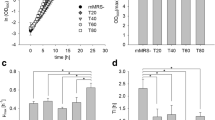Abstract
Non-growing cultures of Streptococcus bovis JB1 which were incubated in 2-[N-moropholino] ethane-sulfonic acid (MES)-phosphate buffer (pH 6.8) and glucose (2 g/l) produced heat at a rate of 0.17 mW/mg protein, and this rate was proportional to the enthalpy change of the homolactic fermentation. Since the growth-independent heat production could be eliminated by dicyclohexylcarbodiimide (DCCD), an inhibitor of F1F0 ATPases, it appeared that virtually all of the energy was being used to counteract proton flux through the cell membrane. When the pH was decreased from 6.8 to 5.8, heat production and glucose consumption increased, the electrical potential (ΔΨ) declined, the chemical gradient of protons (ZΔpH) increased, and there was a small increase in total protonmotive force (Δp). Further decreases in pH (5.8 to 4.5) caused a marked decrease in heat production and glucose consumption even though there was only a small decline in membrane voltage. Based on the enthalpy of ATP (4 kcal or 16.8 kJ/mol), it appeared that 38% of the wattage was passing through the cell membrane. The relationship between membrane voltage and membrane wattage or glucose consumption was non-linear (non-ohmic), and it appeared that the resistance of the membrane to current flow was not constant. Based on the electrical formula, resistance = voltage2/wattage and resistance = voltage/amperage, there was a marked increase in membrane resistance when the pH was less than 6.0. The increase in membrane resistance at low pH allowed S. bovis to maintain its membrane potential and expend less energy when its ability to ferment glucose was impaired.
Similar content being viewed by others
Abbreviations
- DCCD:
-
dicyclohexylcarbodiimide
- MES:
-
2-[N-moropholino] ethanesulfonic acid
References
Bergmeyer HU, Klotsch H (1965) Sucrose. In: Bermeyer HU (ed) Methods of enzymatic analysis. Academic Press, New York, pp 99–102
Clark AJ, Cotton NPJ, Jackson JB (1983) The relation between membrane ionic current and ATP synthesis in chromatophores from Rhodopseudomonas capsulata. Biochim Biophys Acta 723: 440–453
Harold FM (1986) The vital force: a study of bioenergetics. WH Freeman, New York, pp 1–26
Hinkle PC, Kumar AM, Resetar A, Harris DL (1991) Mechanistic stochiometry of mitochondrial phosphorylation. Biochemistry 30: 3576–3582
Hodgman CD, Weast RC, Selby SM (1960) Handbook of chemistry and physics, 41st edn. Chemical Rubber Publishing, Cleveland Ohio, pp 1913–1921
Kashket ER (1982) Stoichiometry of the H+-ATPase of growing and resting, aerobic Escherichia coli. Biochemistry 21: 5534–5538
Krishnamoorthy G, Hinkle PC (1984) Non-ohmic proton conductance of mitochondria and liposomes. Biochemistry 23: 1640–1645
Lowry OH, Rosehough NJ, Farr AL, Randall RJ (1951) Protein measurement with the Folin phenol reagent. J Biol Chem 193: 265–275
Maloney PC (1983) Relationship between phosphorylation potential and electrochemical H+ gradient during glycolysis in Streptococcus lactis. J Bacteriol 153: 1461–1470
Martin SA and Russell JB (1986) Phosphoenolpyruvate-dependent phosphorylation of hexoses by rumen bacteria: evidence for the phosphotransferace system of transport. Appl Environ Microbiol 52: 1348–1352
Mitchell P (1961) Coupling of phosphorylation to electron and hydrogen transfer by chemiosmotic type of mechanism. Nature 191: 144–147
Mitchell P, Moyle J (1968) Proton translocation coupled to ATP hydrolysis in rat liver mitochondria. Eur J Biochem 4: 530–539
Riebeling V, Thauer RK, Jungermann K (1975) The internalalkaline pH gradient, sensitive to uncoupler and ATPase inhibitor, in growing Clostridium pasteurianum. Eur J Biochem 55: 445–453
Rogers HJ (1984) Bacterial cell structure. American Society for Microbiology, Washington, DC
Russell JB (1990) A low affinity, high capacity system of glucose transport in the ruminal bacterium Streptococcus bovis: evidence for a mechanism of facilitated diffusion. Appl Environ Microbiol 56: 3304–3307
Russell JB, Baldwin RL (1979) Comparison of maintenance energy expenditues and growth yields among several rumen bacteria grown on continuous culture. Appl Environ Microbiol 37: 537–543
Russell JB, Dombroski DB (1980) Effect of pH on the efficiency of growth by pure cultures of ruminal bacteria in continuous culture Appl Environ Microbiol 39: 527–543
Russell JB, Robinson PH (1984) Composition and characteristics of strains of Streptococcus bovis. J Dairy Sci 67: 1525–1531
Russell JB, Strobel HJ (1990) ATPase-dependent energy spilling by the ruminal bacterium, Streptococcus bovis. Arch Microbiol 153: 378–383
Segel IH (1976) Biochemical calculations, pp 197–198. John Wiley, New York
Stouthammer AH (1973) A theoretical study on the amount of ATP required for synthesis of microbial cell material. Antonie Van Leeuwenhoek 39: 545–565
Author information
Authors and Affiliations
Rights and permissions
About this article
Cite this article
Russell, J.B. The effect of pH on the heat production and membrane resistance of Streptococcus bovis . Arch. Microbiol. 158, 54–58 (1992). https://doi.org/10.1007/BF00249066
Received:
Accepted:
Issue Date:
DOI: https://doi.org/10.1007/BF00249066




